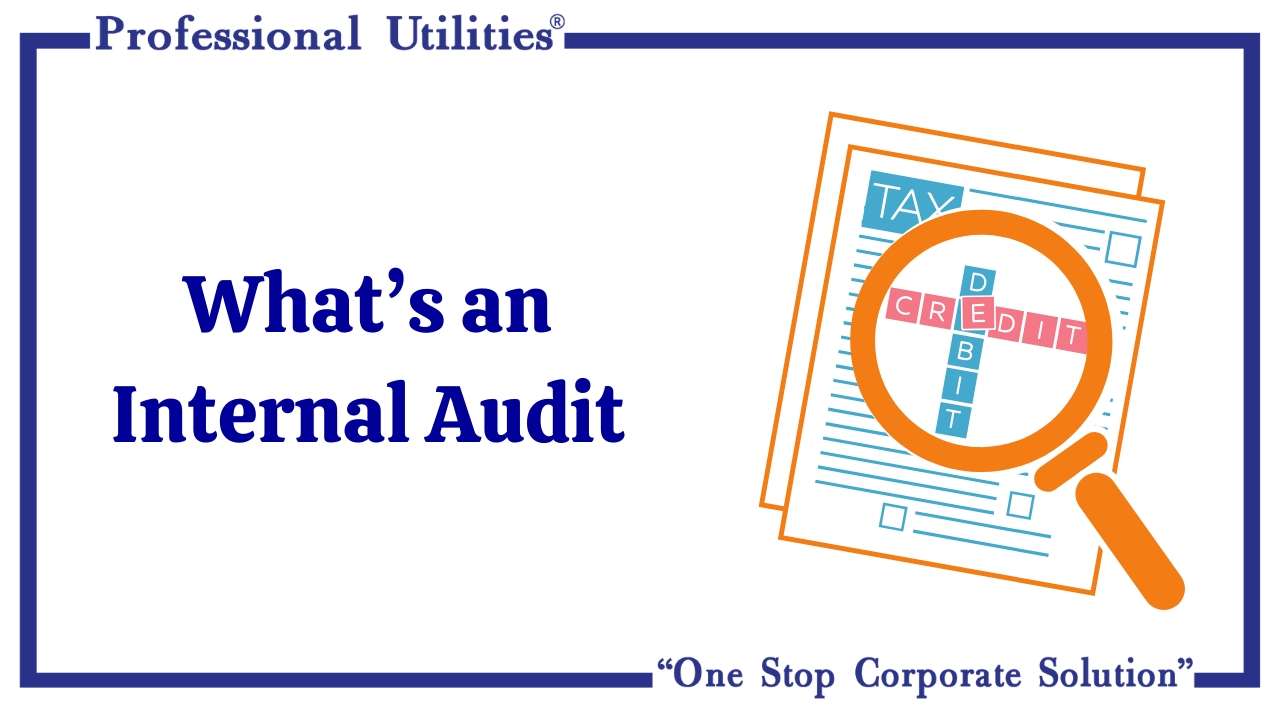
What’s an Internal Audit
Internal Audit is an independent appraisal function established within an organization to examine and evaluate its activities as a service to the organization. It is an independent, objectives assurance and consulting activity designed to add value and improve an organization’s operations. It helps organization to accomplish objectives by bringing a systematic, disciplined approach to evaluate and improve the effectiveness of risk management, control and government process.
Scope and Objectives of Internal Audit
As per AAS-6, Internal Control System refers to all the policies and procedures adopted by the management of the entity to assist in achieving management’s objectives ensuring the orderly conduct of the business, the accuracy and completeness of accounting records, the timely preparation of financial information, safeguarding of assets of enterprises and detection of fraud and errors in a timely manner. The internal audit function constitutes a separate component of internal control with the objective of determining whether other internal controls are well designed and properly evaluated.
- Review of accounting system and related internal controls: Although the establishment of an adequate accounting system and related internal controls is the responsibility of the management, it is essential that they are reviewed from time to time to ensure effective operation and recommend any improvements.
- Examination of Management of financial and operating information: This includes reviewing the methods used to identify, measure, classify, and report such information, along with specific inquiry into individual items and transaction testing.
- Examination of the economy, efficiency, and effectiveness of operations including the financial controls of an organization: This assists the external auditor when such factors have a significant impact on the reliability of financial records.
- Physical examination and verification: This includes verifying the physical existence and condition of the tangible assets of the entity.
The objects of internal audit can be stated as follows:
- Verification of the accuracy and authenticity of the financial, accounting, and statistical records.
- Ascertaining that accepted accounting policies and practices have been followed while preparing the financial accounts.
- The assets are purchased or disposed under proper authorization. Also ensuring that access to assets is restricted to authorized persons at authorized times.
- Confirming that the liabilities are incurred for the legitimate activities of the organization.
- The internal checks system operating in the organization is sound and economical.
- Fraud and errors are prevented and detected.
- Reviewing overall operations of the internal control system and, if deviations or weaknesses are noted, communicating them to the appropriate authorities on a timely basis to help institute corrective actions.
Internal Audit Framework
The operation of the internal audit function should comply with the following code:
- Formal Charter: The internal audit function should have a formal charter, including terms of reference, approved by the board.
- Documentation of Reporting Structure: The reporting structure for internal audit should be clear and formally documented. The head of internal audit should have significant seniority and report directly to the board audit committee, with access to the board chairman and audit committee chairman. Functional reporting should be as determined by the board and to the chief executive.
- Detailed Testing: The internal audit function should conduct detailed testing on all areas covered by the charter to ensure full compliance and report findings to the board audit committee.
- Competency: The internal audit function should possess necessary skills, including capabilities to handle non-financial aspects.
- Liaison with External Auditors: The internal audit function should frequently liaise with external auditors to maximize cooperation. Regular consultations enhance effectiveness and allow mutual support, such as guidance from external auditors and company-specific input from internal auditors.
- Audit Committee and External Auditors: The board audit committee should inform external auditors of corporate governance requirements and periodically consult them on internal audit operations, especially staffing, audit programs, and testing related to compliance with required standards.
- Reviewing: The internal audit body should review compliance with procurement and disposal procedures as directed by the board audit committee and report accordingly.
Relationship between Internal and External Audit
As per AAS-7 on relying upon the work of an internal auditor, the external auditor should as a part of his audit evaluate the internal audit function to the extent he considers that it will be relevant in determining the nature, timing and extent of his audit procedures. The scope and objectives of an internal auditor are determined by the management while the external auditor has to carry out his functions under some statutory requirement Nevertheless, some of the means of achieving their respective objectives are often similar and thus, much of the work of internal auditor may be useful to the external auditor on determining the nature, timing and extend on the procedures. The external auditor should also evaluate the internal audit function to determine the extent of compliance of the substantive and compliance procedures. It is to be noted that the degree of independence an external auditor has it not with the internal auditor and hence, the report of external auditor is his sole responsibility and the fact that he has relied on the work of internal auditor does not in any way absolve him of his reporting responsibility.
Making Internal Audit Effective:
Once the external audit has decided to place reliance on the work of internal auditor, he should coordinate with him, i.e., he should ascertain the internal auditor’s tentative plan for the year ,discuss with him the areas of possible reliance, the extent of internal audit coverage, test methods, methods of sample selection of documentation and review.
Further, the external auditor should be granted access to the internal audit reports and be kept informed of any significant matter which comes to internal auditor’s attention. Similarly, the external auditor should ordinarily inform the internal auditor of any significant matters which may affect his work.
The External auditor should take into account the following factors in relying on the work of internal auditor:
- The adequacy of audit programmes in relation to the scope of the audit report.
- The planning of the work, supervision, and review of the documentation of the assistants.
- The availability of sufficient appropriate audit evidence.
- The appropriateness of conclusions reached and the report thereon.
- Any exceptions or unusual matters disclosed by the internal audit.
Evaluating Internal Audit Function
-
The important aspects that may be considered by the external auditor while evaluating the internal audit function are as follow:
- Organization Status: The external auditor should consider any constraints or restrictions placed by the management regarding the reporting by the internal auditor.
- Scope of Function: The nature and depth of audit coverage should be ascertained by the external auditor, along with whether the management acts upon the recommendations of the internal auditor.
- Technical Competence: The professional competence of the internal auditor should be evaluated.
- Due Professional Experience: The external auditor should ascertain whether the internal audit work has been properly planned, supervised, review and documented
-
To facilitate the accumulation of the information necessary for the proper review and evaluation of internal controls, the auditor can use one of the following to help him to know, assimilate and evaluate the same:
- Narrative Record: This is a complete and exhaustive description of the system as found in operation by the auditor. Actual testing and observation and necessary before such a record can be developed. It may be recommended in cases where no formal control system is in operation and would be more suited to small business. Further, it allows flexibility and can be adapted to any type of enterprise. The narrative record help in the comprehending the system operation, identify the weakness of the system and incorporating the necessary changes in the system.
- Check List: This is a series of introduction or question which a member of auditing staff must follow to answer. When he completes the instruction he must initial the space against each instruction or question. For example, the following check list pertains to the purchase function of a company:
- Is purchasing the exclusive responsibility of the purchase department?
- Are purchases also made on behalf of employees, directors, etc.?
- Is special approval necessary where any purchase is not based on the lowest quoted price?
- Is there any special authorization needed for variation in the terms of a purchase order?
- Are the copies of purchase orders also sent to the accounts department and other store departments?
- Internal Control Questionnaire: This is a comprehensive series of question concerning internal controls. This is the most widely used form for collecting information about the existence, operational efficiency of internal control in an organization. The auditor may prepare a standard questionnaire to be used with suitable modification in the case of all audit engagements or he may prepare a fresh one for each audit engagement. The question should be designed that answer can be provided by a mere ticking of the words, “yes” or “no” or “ not applicable” .Questionnaires are generally favored in case of audit of large enterprises because a considerable amount of time is saved for the auditor by eliminating the need for preparing a program for each engagement.
- Flow Chart: It is a graphic presentation of each part of company’s system of internal control. A flow chart is considered to be the most concise way of recording the auditor’s review of the system of the system. It minimizes the time involved in getting narrative explanation and gives bird’s eye view of the system.
It is to be noted all of the above mentioned techniques to evaluated internal controls can be effective only if the auditor has an understanding of the client’s business.
Why Choose Our Internal Audit Services?
- Our skilled professional auditors adopt a risk-based approach focusing on the objectives and constraints of our clients to achieve those objectives.
- Our services have been developed for the consistent executive ordinances in all internal audit practices throughout the world.
- We go further than traditional basics and add tangible value.
- We work to build the internal audit into a convenient and productive tool in today’s Corporate Governance Committee environment.
- We are providing expertise to implement the audit work in specialized areas such as fraud investigations, monitoring of projects, implementation of systems, revenue assurance, IT, etc.
- Our expert team also serves clients in various industries like Manufacturing, Financial Services, Telecommunications, Information Technology, Healthcare, Media & Entertainment, and Consumer Business.
- Our internal audit services can assist both you and your counsel with a comprehensive and disciplined approach that gives practical solutions, not just strong reports.
- Our specialists and services are focused on value creation and offer you the vision and foresight throughout the enterprise as a whole, to address the future head-on.
Why Professional Utilities?
Professional Utilities simplify registrations, licenses, and compliances for your business. With experienced guidance and nationwide support, we help you complete every requirement efficiently and effectively.

Complete Corporate Solutions

PAN India
Assistance

Free Expert
Guidance

Google-Verified
Team

Dedicated Support


.svg)







